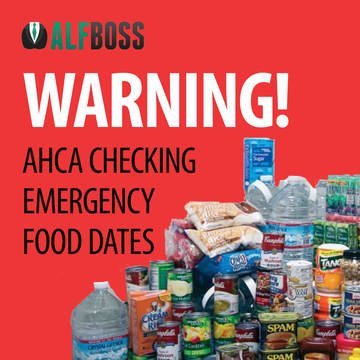
One of the most important things you can do for the residents of your ALF is to make sure that you have enough food and water to sustain them in the event of an emergency. AHCA mandates the amount that you need to have in your emergency supply at all times in ST – A0093 – Food Service – Dietary Standards:
“A 3-day supply of nonperishable food, based on the number of weekly meals the facility has contracted with residents to serve, must be on hand at all times. The quantity must be based on the resident census and not on licensed capacity. The supply must consist of foods that can be stored safely without refrigeration. Water sufficient for drinking and food preparation must also be stored, or the facility must have a plan for obtaining water in an emergency, with the plan coordinated with and reviewed by the local disaster preparedness authority.”
After you’ve finalized your list of emergency supply food items in consultation with a licensed dietitian; procured the food items; and stored them properly in a cool, dry place, your next most important task is to come up with a system to keep track of the expiration dates of the items in your supply. The food in your supply must always be within date to remain in compliance with AHCA , and to optimize the safety and well-being of your residents should there be an emergency.
First, keep a comprehensive inventory of the items in your emergency supply that includes the name of each item, the date of purchase, the expiration date printed on the package, and the volume. Conduct a quarterly audit of your emergency supply and transition any items that are a month out from expiration into your regular supply. Then, immediately replace those items in your emergency supply and update your inventory accordingly.
In the event that you must use an item in your emergency supply, be sure to use the first in, first out system in which you use items purchased the earliest before items purchased more recently. You will need a system to make sure that you know which can of peaches, say, was purchased before a duplicate of the exact same item. You can affix labels to each item that indicate the date of purchase and the expiration date in addition to keeping track of that information in your inventory.
Finally, if you open a package from your emergency supply, immediately transition it into your regular supply. Replace the item in your emergency supply with an unopened package and update your inventory.
In order to safeguard these processes, codify them in the policies of your facility and integrate them into the regular training of your employees.